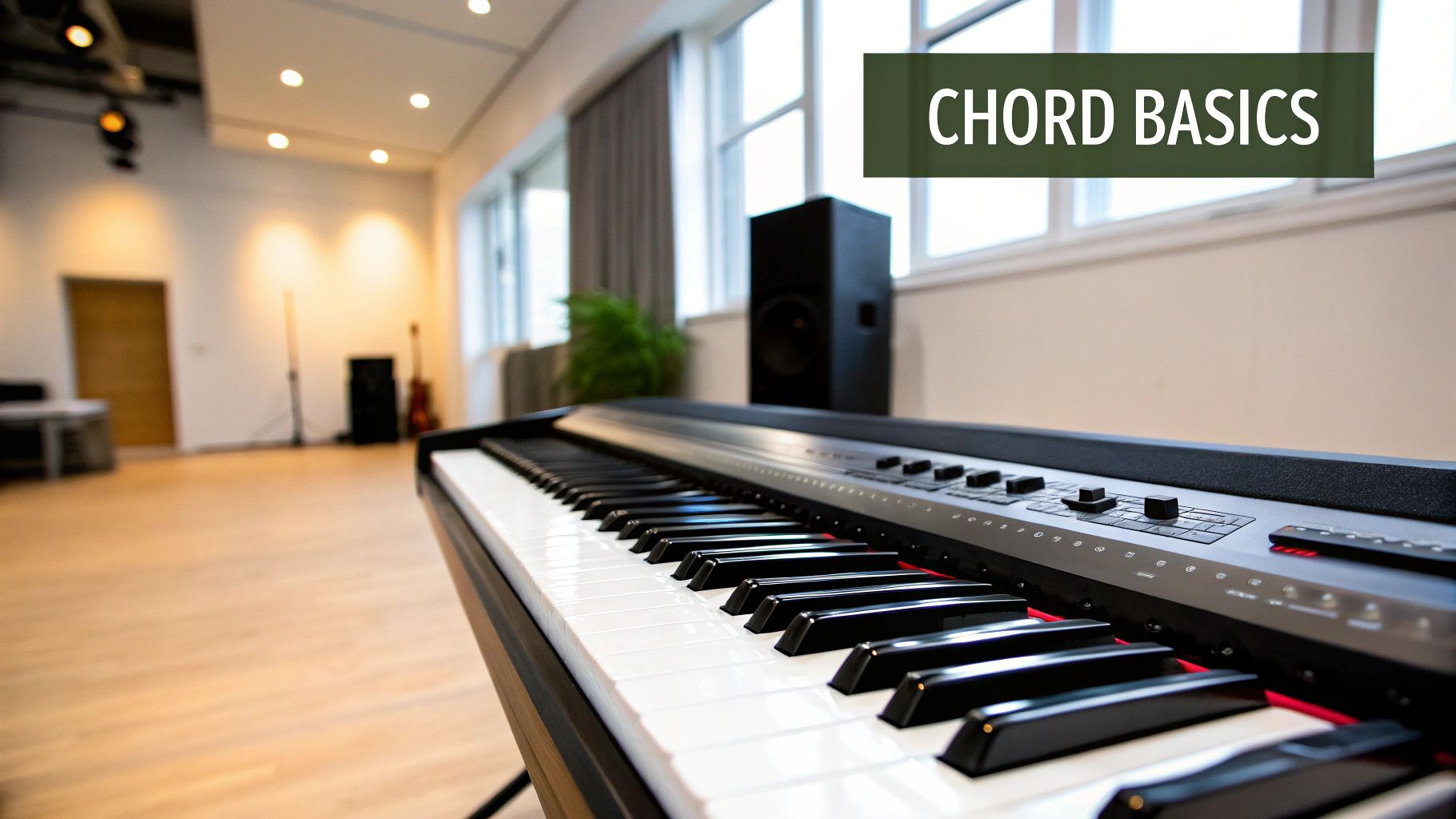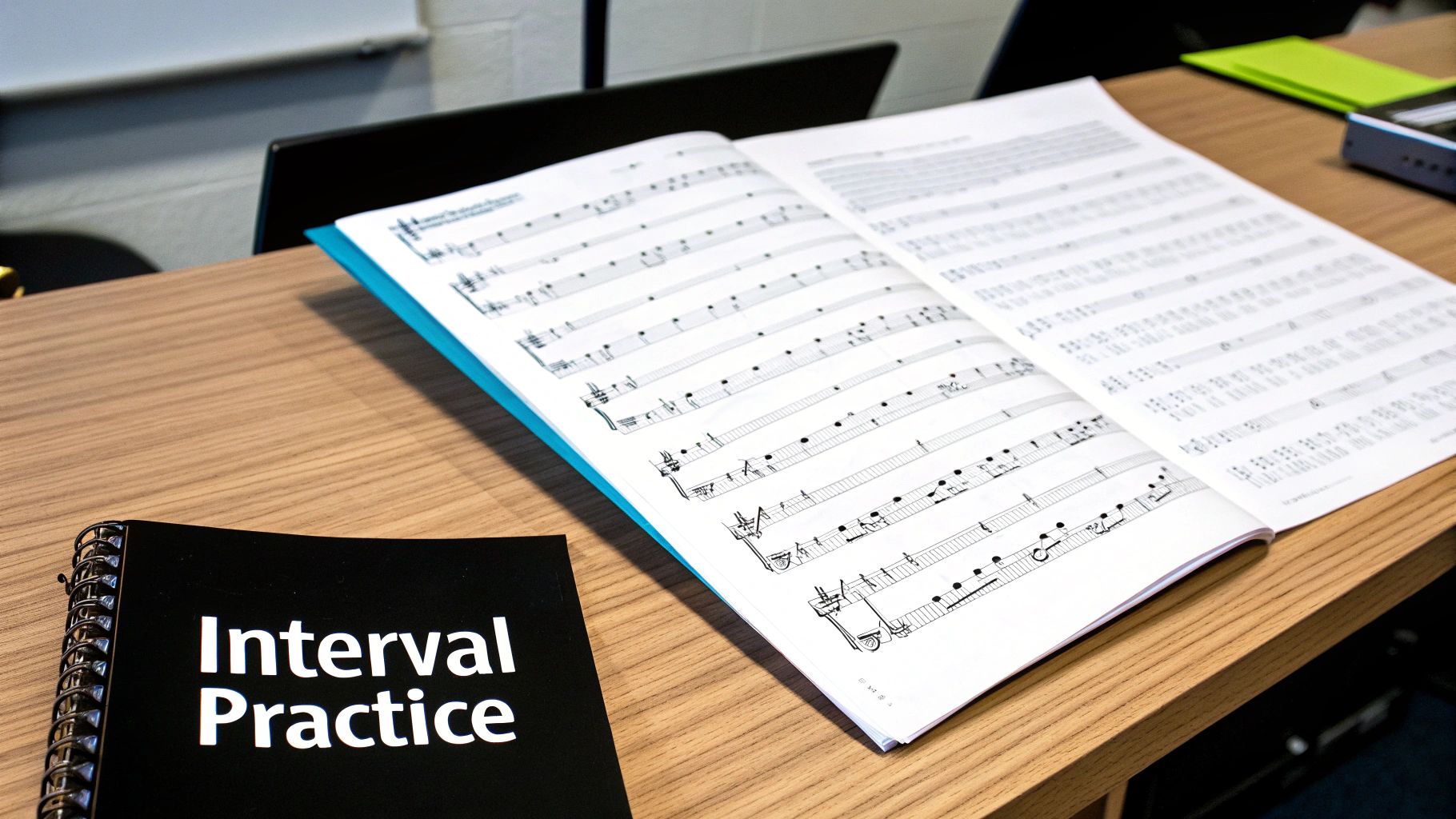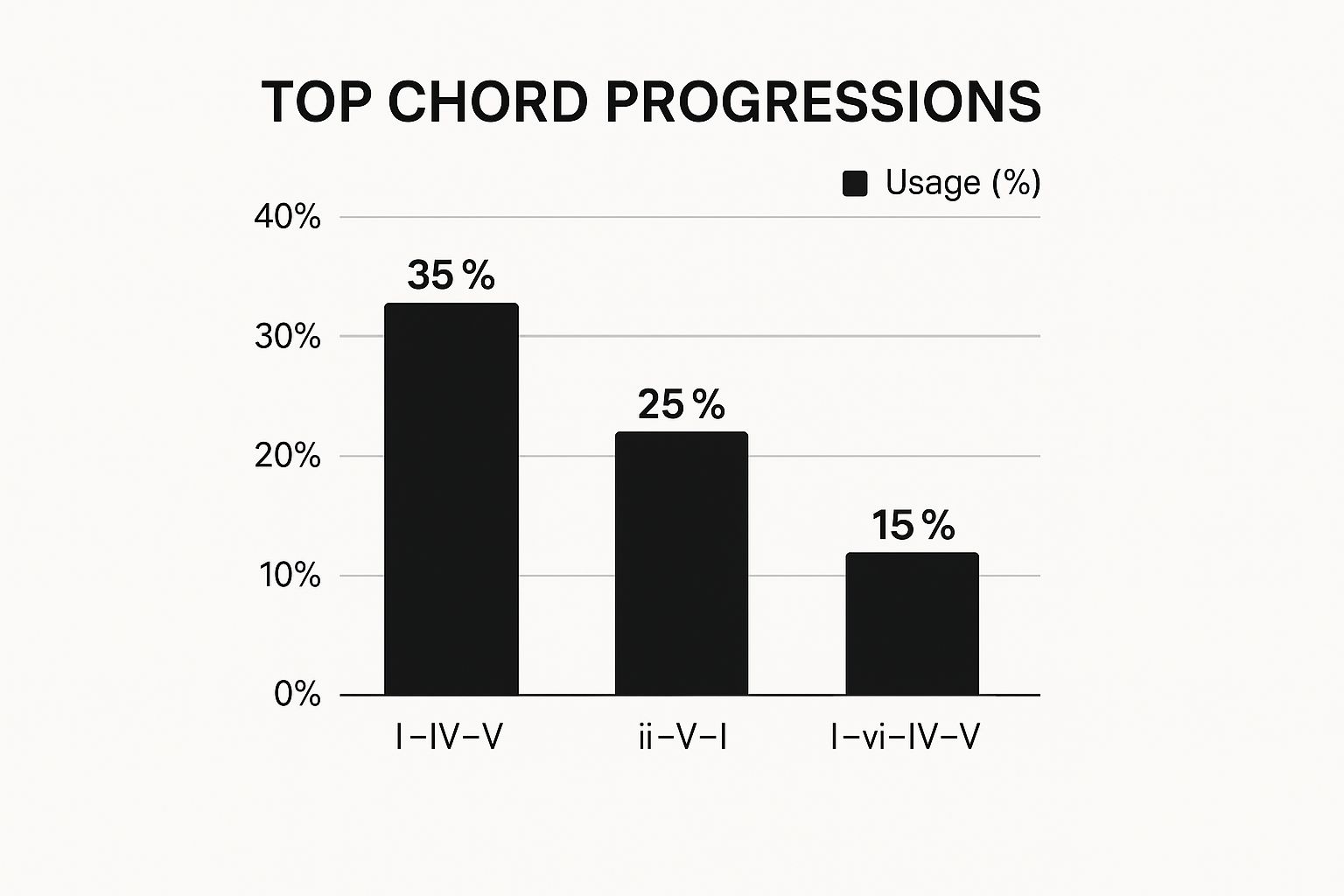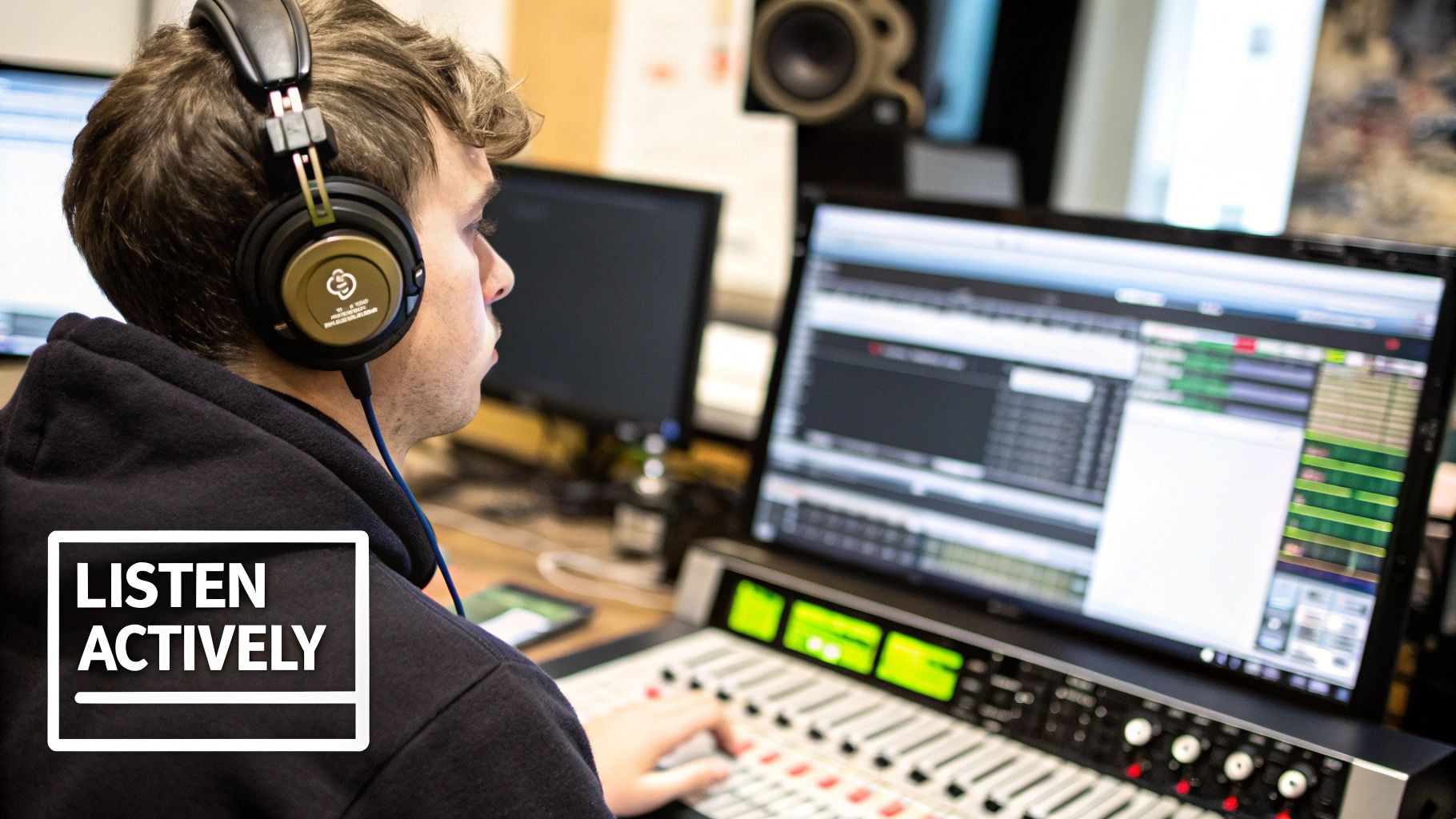Master Chord Progression Ear Training
Unlock your musical potential with our guide to chord progression ear training. Learn to recognize harmonies by ear with practical, real-world exercises.
Posted by
Joe BrewerRelated reading
Music Intervals Training: Boost Your Ear & Skills Today
Master music intervals training with expert exercises and tips. Enhance your ear training skills quickly and effectively. Start improving now!
Understanding the Circle of Fifths: A Musician's Essential Guide
Master understanding circle of fifths with this comprehensive guide. Learn to read, build chords, and enhance your music skills today!
How to Learn Music by Ear and Master Songs
Discover how to learn music by ear with actionable techniques and real-world exercises. Transform your musical skills and start playing any song you hear.
Master Chord Progression Ear Training
Ever hear a song for the first time and just know what chords are being played? That’s the magic of chord progression ear training. It's a real-world skill that closes the gap between simply hearing music and truly understanding its harmonic backbone. Trust me, it's not some gift reserved for a select few—it’s something you can absolutely learn, and it will completely change how you play, write, and even listen to music.
Why Ear Training Is Your Musical Superpower

Honestly, developing your ear is one of the most powerful things you can do for your musicianship. It’s the difference between blindly following a chord chart and intuitively feeling where the music wants to go next. Once you can identify progressions by ear, a whole new world of musical freedom opens up.
This isn’t about dry, abstract theory. It’s about building a practical, internal library of sounds. You’ll start to recognize the emotional pull of different progressions, like the classic, upbeat feel of a I-IV-V or the wistful, nostalgic sound of a I-V-vi-IV. It’s like learning the grammar of music—suddenly, you can understand its language and speak it fluently.
Learn Songs Faster
Are you tired of constantly searching for chord charts every time you want to learn something new? A well-trained ear slashes the time it takes to pick up new material. Instead of depending on a tab or a YouTube tutorial, you can just listen to a song and start figuring it out on your instrument almost immediately.
This skill is a game-changer in jam sessions or when you're asked to learn a song on the spot. You'll hear the chord changes, recognize the pattern you've heard a thousand times before, and find the shapes on your instrument in real-time.
Improvise With Confidence
Great improvisation isn't just pulling notes out of thin air. It's a conversation with the harmony happening underneath. Knowing the chord progression gives you a roadmap, allowing you to make melodic choices that sound intentional and deeply connected to the music.
When you can hear the chord changes coming, you can anticipate them with your melodies. You start creating lines that beautifully outline the harmony instead of just noodling aimlessly. This is the secret to crafting solos that really tell a story.
A solid ear for harmony lets you:
- Target chord tones to build strong, solid melodies.
- Play "outside" the changes deliberately to create tension and release.
- React instantly to what the other musicians are doing in a live band setting.
At the end of the day, ear training builds a deep, intuitive bond with music. It takes harmony from being an idea in your head to a feeling in your gut, making you a more versatile, confident, and expressive musician. The journey starts with simple listening exercises, and with a little consistent practice, you'll be blown away by what your ears can learn to "see."
Building Your Sonic Foundation

Before you can pick out a full I-V-vi-IV progression in a song, you need to get familiar with its individual parts. Think of it like this: you can't understand a sentence until you know what the words mean. Your chord progression ear training starts with the most basic building blocks of harmony.
The first real step is learning to hear the distinct emotional quality—the "mood"—of a single chord. The good news is, you probably already have an intuitive feel for this.
- Major Chords: These are the ones that sound bright, happy, and resolved. They're the sound of a big pop anthem or that "happily ever after" moment in a movie.
- Minor Chords: These feel darker, more somber, or full of tension. They give a ballad its heartache or a film score its drama.
Sit down at a piano or grab your guitar. Play a major chord, then a minor one. Close your eyes and really listen to the shift in feeling. This simple act of telling major from minor is the first, crucial file you'll add to your internal sonic library.
Hearing The Spaces Between
Once you're comfortable with the feel of individual chords, the next layer is learning to hear intervals. An interval is just the distance between any two notes. They're the raw material that every melody and every chord is made from.
Recognizing intervals is all about connecting each one to a specific sound and feeling. A perfect fifth, for instance, has a strong, open, and stable sound—it’s the backbone of countless rock power chords. A tritone, on the other hand, sounds tense and unresolved, creating an immediate sense of unease.
The goal isn't just to put a name to an interval. It's about internalizing its unique character. When you can instantly hear the difference between a major third and a minor third, you're not just memorizing theory; you're starting to decode the DNA of the music itself.
A fantastic trick here is to use reference songs you already know. The first two notes of "Twinkle, Twinkle, Little Star" are a perfect fifth. That famously menacing theme from Jaws? That's a minor second. Anchoring these sounds to familiar tunes makes them stick.
Systematizing Your Practice
To really make progress, you need consistent, structured practice. This is where modern tools can give you a serious edge. Some apps are built specifically to walk you through this process in a logical way.
A well-designed app provides a clear roadmap from the absolute basics to more advanced concepts. Take the Complete Ear Trainer app, for example. It starts you off with over 150 progressive drills, covering everything from simple intervals to 36 different chord types. It even has more than 21 drills dedicated just to progressions. This kind of systematic approach is incredibly effective for building relative pitch and chord recognition from the ground up.
By breaking down the big, complex skill of hearing progressions into these smaller, manageable chunks—first chord moods, then intervals—you create a solid foundation to build upon. This methodical approach ensures you're truly learning the language of harmony, not just taking wild guesses.
Learning the Language of Pop, Rock, and Blues
This is where the rubber really meets the road in your ear training journey. Once you can pick out individual chords and hear the space between notes, the next step is recognizing how those chords string together to tell a harmonic story. Certain progressions are so foundational to Western music that they’ve become the unspoken language of pop, rock, and blues.
Learning this language isn't about memorizing a million different combinations. It's about getting a feel for the function of each chord within a key. Think of the "I" chord (the tonic) as home base. It’s that feeling of resolution, stability, and finality. Other chords, like the "V" (the dominant), build a powerful tension that creates a magnetic pull, making you practically crave a return to that "I" chord.
The Power of the Big Three: I, IV, V
Let's start with the absolute bedrock of modern music: the I-IV-V progression. This simple, strong, and incredibly effective sequence is the engine behind so much early rock and roll, country, and, of course, the blues.
- The I Chord (Tonic): This is your home base. It’s the starting line and the finish line, and it always feels resolved.
- The IV Chord (Subdominant): This chord provides a gentle lift, a feeling of moving away from home without creating any real tension. It’s a pleasant departure.
- The V Chord (Dominant): Here comes the tension. This chord creates a powerful expectation that the music is about to circle back to the I chord. It feels unresolved on its own.
Countless songs are built almost entirely on these three chords. Just think of the driving energy in "Twist and Shout" by The Beatles or the entire structure of the classic 12-bar blues that has shaped so much of music history. Hearing the I-IV-V is about recognizing that fundamental journey: home (I), a little side trip (IV), building anticipation (V), and that satisfying return home (I).
The Emotional Sound of Modern Pop
While the I-IV-V is a timeless classic, the sound that has absolutely dominated pop music for the last few decades is the I–V–vi–IV progression. If you've listened to the radio at all in the last 20 years, you have heard this sequence hundreds, if not thousands, of times.
It has a distinct emotional flavor. Starting with I-V gives it a strong, confident opening, but then it shifts to the "vi" chord—the relative minor. This little move injects a touch of melancholy or nostalgia into the mix before the IV chord guides you back to the start of the loop. It’s this predictable yet emotionally resonant cycle that makes it a songwriter's go-to.
The real breakthrough in your chord progression ear training comes when you stop hearing individual chords and start hearing these functional relationships. You'll hear a V chord and feel its need to resolve; you'll hear a vi chord and recognize that signature wistful sound.
The chart below shows just how dominant a handful of progressions are in the music we listen to every day.

As you can see, a surprisingly small number of harmonic patterns really do form the backbone of a huge percentage of popular music.
To help you connect the Roman numerals to what you're actually hearing, I've put together a table of some of the most common progressions you'll encounter. Pay attention to the "Characteristic Feel" – that's the emotional core you want to train your ear to recognize.
Common Diatonic Progressions And Their Sonic Feel
| Progression (Roman Numerals) | Characteristic Feel | Popular Song Example |
|---|---|---|
| I - IV - V | Classic, strong, foundational (The "campfire" chords) | "La Bamba" by Ritchie Valens |
| I - V - vi - IV | Optimistic with a touch of nostalgia (The "pop-punk" progression) | "Don't Stop Believin'" by Journey |
| vi - IV - I - V | Somber, epic, serious, reflective | "Africa" by Toto |
| I - vi - IV - V | Sweet, nostalgic, sentimental (The "'50s progression") | "Stand By Me" by Ben E. King |
| ii - V - I | The cornerstone of jazz; smooth, sophisticated resolution | "Autumn Leaves" by Joseph Kosma |
This isn't an exhaustive list, of course, but internalizing the sound of these five progressions will give you a massive head start in deciphering the music you hear all around you.
How to Practice Hearing Progressions
The best way to get these sounds into your head is through focused, active listening. Don’t just put music on in the background. Instead, grab a song you know well that uses one of these common patterns, like "Let It Be" (I-V-vi-IV) by The Beatles.
- First, find the "I" chord. Listen for the moment in the song that feels most like home base, where everything feels resolved. Try humming its root note throughout the song to keep your bearings.
- Next, follow the bass. The bass player is your best friend here, as they often play the root note of each chord. Try to sing along with the bassline's movement from one chord to the next.
- Then, map the journey. As the chords change, ask yourself what you’re feeling. Does this new chord feel stable (I), like a gentle lift (IV), full of tension (V), or a little bit sad (vi)?
- Finally, check your work. After you’ve made your best guess, go look up the chords to the song online. See how your ears lined up with reality!
This process is what bridges the gap between abstract theory (the Roman numerals) and the real-world sound of music you already know and love. After a while, you won’t need to guess anymore. You’ll just know.
Hearing Harmony Beyond The Basics

Okay, so you've got the basic diatonic progressions down pat. You can hear a I-V-vi-IV coming a mile away. Now, it's time to dig into the really cool stuff—the sounds that give music its unique flavor and emotional depth.
Most of the harmonic richness you love in jazz, R&B, and even sophisticated pop comes from chords that break the "rules" of a single key. These aren't just random notes; they're intentional choices that add tension, surprise, and color. This is where your chord progression ear training goes from a technical skill to a true art form.
Spotting Borrowed Chords
One of the most powerful and common ways to add color is through a technique called modal interchange, which is really just a fancy way of saying "borrowed chords." It's when a song that's mostly in a major key nabs a chord from its parallel minor key to create a specific mood.
The most frequent visitor is the minor iv chord. Let's say we're in the key of C Major. The normal IV chord is F Major—bright and happy. But suddenly, you might hear a darker, more soulful F minor chord instead. That's it. Your ears just caught modal interchange in action. This is the exact sound that gives "Creep" by Radiohead its signature angst.
Once you start recognizing these borrowed chords, you’re not just naming functions. You're hearing the deliberate mix of major and minor emotions within one piece of music. It’s a huge milestone for your musical ear.
Your job is to listen for that subtle but powerful emotional shift. When a chord just feels a bit darker or more poignant than you'd expect for its place in the key, chances are you've stumbled upon a borrowed chord.
The Power Of Secondary Dominants
Here's another one you'll hear everywhere once you know what to listen for: the secondary dominant. It sounds complicated, but the concept is actually pretty straightforward. It’s a chord that’s sole purpose is to make another chord (that isn't the tonic) feel like a temporary destination.
You already know the powerful magnetic pull the V chord has back to the I chord. A secondary dominant creates that exact same feeling of tension and release, but it points to a different chord within the key.
Let's imagine a real scenario. You're listening to a song in C Major, and the progression moves to a D Major chord. Your diatonic brain might short-circuit for a second—the ii chord in C is supposed to be D minor.
- What you're hearing: A major II chord (D Major).
- What it's doing: That D Major is acting as the V chord of G Major. And what's G Major in our key? It's the V chord. So, you're hearing the "V of V." It's a secondary dominant that builds a powerful launchpad to the G chord that comes next.
- The sound: It's a sudden burst of bright, forward-moving energy that makes the arrival of that G chord feel even stronger and more satisfying.
You hear this trick in everything from classic rock anthems to Broadway showstoppers. It's that moment of unexpected brightness that kicks the harmony into a higher gear.
To start hearing these, listen for major chords popping up where you'd normally expect a minor (like a major II, III, or VI chord). Then, pay close attention to the very next chord. Nine times out of ten, you’ll hear that satisfying resolution, and you'll know you've spotted a secondary dominant in the wild.
Let's be honest, ear training used to feel like a lonely, uphill battle. Just you, a piano, and a whole lot of trial and error. But we're living in an incredible time for musicians. The right technology can be a massive game-changer for your chord progression ear training, giving you the kind of structured, instant feedback that once required a private teacher.
https://www.youtube.com/embed/Wzqa44N-sIU
This isn't just a niche corner of the music world, either. The market for ear training apps was already valued at around $250 million back in 2022, and it’s expected to balloon to $450 million by 2030. That explosion is fueled by musicians everywhere who want to sharpen their skills on their own terms. If you're curious about the numbers, you can dive into this detailed market report on ear training apps to see the global trends.
Level Up With Dedicated Ear Training Apps
Think of a good ear training app as your personal, endlessly patient tutor. The best ones turn what could be a chore into a genuinely fun, game-like experience. Instead of just fumbling around trying to find chords, these apps serve up structured drills that get progressively harder as you get better.
When you're shopping around, look for a few key features:
- Customizable Drills: This is non-negotiable. You need the ability to isolate specific progressions, like drilling the difference between a I-IV-V and a I-V-vi-IV. This is how you target your weak spots.
- Progress Tracking: Nothing fuels motivation like seeing your accuracy climb. A great app will show you exactly where you're succeeding and where you need to put in more reps.
- Real Instrument Sounds: High-quality piano, guitar, and bass samples make the exercises feel musical and translate directly to what you'll hear in actual songs.
These features work together to create a powerful feedback loop. You practice, get immediate results, and know exactly what to work on next. It's a systematic approach that’s worlds more efficient than just unstructured noodling.
Turn Chord Generators into Active Listening Tools
Here’s a trick most people miss: chord progression generators aren't just for overcoming writer's block. They are fantastic—and seriously overlooked—tools for active listening practice. The idea is simple, but it’s incredibly effective for building your recognition skills from the ground up.
The real magic happens when you flip a composition tool into a listening tool. You generate a random, unknown progression, which forces your ear to analyze it from a neutral perspective without any preconceived notions.
Here’s a simple workflow you can start using today:
- Generate a Progression: Fire up an online generator and have it create a simple, four-chord loop, all within one key.
- Listen and Identify: Now, play the loop. Close your eyes and really listen. Is that first chord major or minor? Can you feel the tension and release of the V chord resolving back to the I? Try to map it out in your head using Roman numerals.
- Check Your Work: Once you think you have it, peek at the answer. How did you do?
- Rinse and Repeat: Do it again. And again.
This little exercise is a perfect, low-pressure way to get in your daily reps. It systematically builds your ability to hear, identify, and internalize the sounds of different harmonies in a controlled environment, making your ear training far more effective.
Answering Your Biggest Ear Training Questions
When you start digging into ear training for chord progressions, some real-world questions—and, let's face it, a few frustrations—are bound to pop up. Getting straight answers helps you stay on track and power through those moments when progress feels slow.
Let's tackle some of the most common concerns I hear from other musicians.
How Long Does This Really Take?
There's no magic number, but I can tell you this from experience: consistency is everything. A focused 15-20 minute practice session every day will do more for you than a massive two-hour cram session once a week. It's about building a habit, not just clocking hours.
You’ll probably start noticing real, tangible progress in recognizing basic progressions within a few months. But for the deeper stuff, like instantly calling out complex harmonies in a jazz tune? That's a skill that develops over a year or more of dedicated work. Trust the process and celebrate those small victories. They add up.
Do I Need Music Theory First?
While a little theory definitely helps, it's absolutely not a deal-breaker. In fact, a lot of musicians find that training their ear is what makes abstract theory concepts finally "click."
Think of it this way: ear training lets you discover the sound first. Theory then gives you the language to label what you’re hearing. By letting your ear lead, you make the whole learning process feel more intuitive and musical, rather than getting bogged down in terminology before you've even built a sonic reference library in your head.
How Can I Apply This To My Instrument?
This is the most important part. The whole point is to close the gap between what you hear and what you can play. This skill is only truly useful when you put it into action.
Here's how to make it stick:
- Start small. If you're using an app to drill a I-V-vi-IV progression, stop and immediately find it on your guitar or piano. Feel it under your fingers.
- Listen actively. The next time you're listening to a song you love, pause it right after a chord change. Before you hit play, try to hunt down the root note of that new chord on your instrument.
This constant back-and-forth between listening and playing is what cements the skill. It transforms it from a sterile exercise into a practical tool you can actually use.
Plateaus aren't just normal; they're a healthy part of the journey. Hitting a wall doesn't mean you've stopped learning—it's a signal that it’s time to switch up your approach. You've simply outgrown your current method.
When you feel stuck, take a step back. Go back to basics for a day or two, just drilling the difference between major and minor chords. It can be a fantastic reset. Or, try something completely different, like transcribing a simple vocal melody by ear. Sometimes, the best way to break through is to give your brain a new puzzle.
These skills are increasingly supported by modern tools. The market for chord progression generators, which was valued at $150 million in 2023, is projected to climb to $350 million by 2032. This surge shows just how much musicians value tools that help with harmony. If you're curious, you can check out the full market analysis on chord progression generators for a deeper dive.